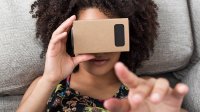Ripping Learning off the Page
Virtual reality headsets and 360-degree videos are cheap—or even free!—tools you can use to help students experience distant places and the lives of others.
Virtual reality is a powerful, low-cost, easy-to-access resource for teachers. You can create deep, meaningful learning experiences for students with VR using a headset like the inexpensive Google Cardboard. With this device and a smartphone, students can be transported instantly to different places around the world. If using headsets and smartphones isn’t the best fit for your class, there are many 360-degree video experiences viewable on iPads and Chromebooks that provide a VR-like experience.
As a former one-to-one iPad teacher and big fan of scannable technology, I’m excited by the potential of virtual reality to support reading instruction. Virtual reality has the capacity to capture the attention of our students, and we can use this technology to elevate traditional learning experiences that connect to learning goals. There are a few ways you can do that.
Imagine you are about to read a new piece of literature with students. A virtual reality experience can take them on a tour of the setting of a book. If your students are reading a picture book like Amelia and Eleanor Go for a Ride, you can take them on a quick trip to Washington, DC, to introduce them to landmarks. A prereading activity can help spark interest in a topic and introduce students to content that will boost their comprehension. The folks at Nearpod have great virtual reality lessons for different ages, and you can search for VR content to add to the lessons you create. This helps you customize a lesson to connect directly to your goals for readers in your classroom.
Building Background Knowledge
Virtual reality can also be used to help students build background knowledge on a topic. Instead of simply jumping into a biography of John Muir, you can take students on a virtual hike of Yosemite National Park to show off the landscape of this region. By providing this kind of experience for students, you create context for their reading of informational text. One new app I’m excited about is Parks Explorer, which provides immersive 3D experiences of national parks for students.
Students are often quick to make text-to-self connections, relating the events of a story or traits of a character to their own life. Virtual reality can help students make text-to-world connections. The Discovery Channel’s VR content does a great job of transporting users to destinations around the world.
In addition to activities that might take place before a reading lesson, virtual reality can be used for reading extensions. If your students show great interest in a particular topic presented in their reading, you can find a range of 360-degree videos compatible with Google Cardboard or accessible on a web browser. I’m a fan of the 360-degree videos from the BBC, especially the ones tied to concepts presented in the Planet Earth series. Reading extensions might feel natural when students are exploring informational texts and can also help address their questions as they make meaning of new information.
Building Empathy in All Subject Areas
The idea of empathy in education isn’t new. Edutopia blogger Lauren Owen shared some of her ideas around this topic in an article titled “Empathy in the Classroom: Why Should I Care?” The New York Times’ virtual reality content does a great job of helping students build empathy. You might have students read a series of news articles and then try out a VR experience with the Times’ app, which can help students understand life in other parts of the world better than they would with the articles alone. And it’s been exciting to see the way established companies like Nearpod incorporate virtual reality into their lessons, understanding the potential for using this technology to help students build an emotional connection to content.
I’ve had the chance to share virtual reality with teachers during workshops where everyone is on their feet spinning in one direction or another. In these instances, educators see connections to their work pretty quickly, and we spend time discussing how to integrate virtual reality into their everyday lessons. Books make us laugh and feel for the characters we grow to love. Virtual reality can help students connect to the lives of characters by placing them on the ground for simulated, shared experiences.
Although this technology hasn’t exactly taken classrooms by storm, the potential for thoughtful integration is real. Virtual reality has the power to transform everyday lessons and transport students to new places.
